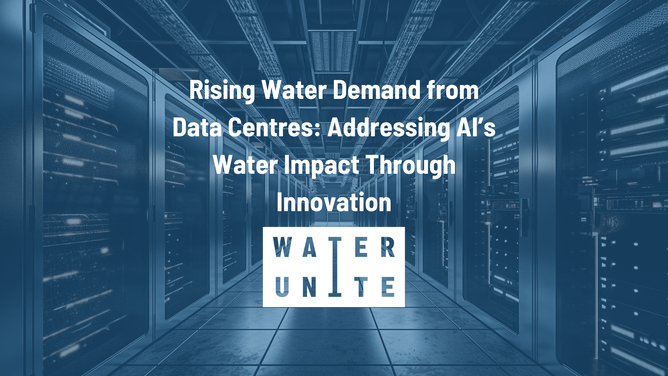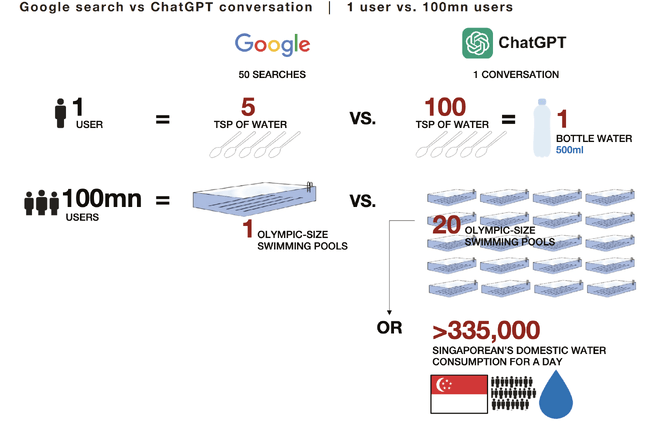As more companies adopt AI-enabled strategies and embrace technological advancements, it’s important to consider the environmental impact, particularly on water resources. Fortunately, leaders in the technology sector are already taking proactive steps to address and reduce the risk of water scarcity, but there is certainly more work to be done.
Unveiling the Water Demands of AI
Although the amount of water used can depend on various factors, research has shown that on average, a data centre uses approximately 300,000 gallons of water per day (Gupta, 2025). This is equivalent to water use in 100,000 homes (Roux, 2025). By 2027, AI’s water usage is projected to reach an alarming 6.6 billion m³ (Gordon, 2024), underscoring the urgency of addressing AI’s water footprint.
Every conversation with ChatGPT carries an invisible cost: a bottle of water vanishes behind the scenes with every few dozen questions (Euronews, 2023). While one bottle of water for a few dozen questions may seem trivial, when multiplied across billions of users, the environmental cost of AI becomes clear.
At the heart of AI’s water consumption is its reliance on data centres, which are essential for both training complex models and serving users' requests around the clock. These centres require water to cool equipment, as temperature control is crucial for the operation of servers and storage drives (Zewe, 2025). As AI infrastructure continues to scale, global water consumption is also increasing steadily, demonstrating significant environmental cost (Gordon, 2024). In addition, they often use fresh water in order not to clog pumps with contaminants (Kleinman & Wheeler, 2025).
Reliance on clean water further intensifies pressure on freshwater resources, particularly in water-scarce regions. Large quantities of water are being used and removed from local water cycles (Olson et al., 2024), creating tension between technological progress and water security. Moreover, cooling systems in these data centers heat the water used, which cannot be released back into the environment due to the risk of thermal pollution and subsequent ecosystem damage (Gupta, 2025).
With that being said, AI is not the only industry using data centres that require cooling systems. Other digital technologies in the sector utilise data centres for their operations, such as platforms that store data in a cloud. Water usage is not just an AI issue, but a broader risk as the world’s reliance on digital technology continues to rise.
Source: China Water Risk (CWR) - China ICT running dry? The rise of AI & climate risks amplify existing water risks faced by thirsty data centres.
The Global Impact of AI's Water Demand
Data centres can be found across the globe. A recent map compiled from sourced data suggests there are over 600 centres active or in development. Many of the largest data centres can be found in the United States, particularly spread across California, Arizona and Virginia (Barringer, 2025). Interestingly, while many of these regional hubs likely offer infrastructure incentives for developers, they are often located in water-scarce regions. For example, in the case of Arizona, the state is becoming a fast-growing data centre hub. Yet parts of the state, such as Mariposa County, are facing “extreme drought” (The Guardian, 2025), adding pressure to the already overstretched watersheds. However, this trend is not specific to North America.
Concerns for increasing water consumption have also been raised in parts of South America due to the rise in new data centres. In the case of Uruguay, local communities have voiced concerns and even protested the development of new facilities due to their unsustainable use of water, as they are still recovering from an extended period of drought (Gupta, 2025). Similarly, in Chile, fears have also risen surrounding the issue, as data centres would tap into “the same reservoirs that supply drinking water” (Berreby, 2024).
In Europe, protests have also emerged in Aragon, Spain, where demonstrators used the slogan "Your cloud is drying my river" (Woollacott, 2024). Each of these cases demonstrates that the issue is a global trend. Driven by growing water demands, local communities, particularly in arid regions, are urging these facilities to adopt long-term sustainable water management practices (Zilien, 2023).
Rethinking Water in AI: How Tech Giants Are Tackling Water Use
While the growth of AI poses new challenges to water security, many tech giants today are seeking to champion solutions that mitigate such risks. Although the solutions may not be straightforward, several strategies are emerging. For example, Meta pledged that by 2030, it would “restore more water to the region than it used”, highlighting their water replenishment strategy. Similarly, Amazon Web Services (AWS) have also pledged to become “water-positive by 2030” (Barringer, 2025).
Water recycling strategies are also being adopted by corporates, where water used in data centres is being reused, effectively creating self-sufficient water systems. Going a step further, some corporates have pledged to even reclaim wastewater instead rather than using drinking water (Gupta, 2025). Through new and innovative technologies, water recycling offers a cost-effective solution to the problem by reducing withdrawals from local freshwater sources (Zilien, 2023).
Although emerging solutions are scalable, they must still be adapted to the local context. Studies have shown that "matching solutions to the local area” is key, involving consideration of local water systems through due diligence to ensure both efficiency and equity for stakeholders. Some solutions may be better suited to different geographies. This can be illustrated in the case of rainwater harvesting. With the use of “blue roofs”, data centres can collect rainwater, a method which reduces stress on the local water supply (Campbell, 2024). This approach highlights yet another practical solution that can be implemented within supply chains.
Looking Ahead: Leveraging AI for Water-Smart Solutions
AI technology itself can also be part of the solution. Our partners, Seabex, are an example of this. Their AI-powered platform revolutionises irrigation practices by using sensorless technology to deliver cost-effective irrigation recommendations with comparable accuracy to traditional methods (Seabex, 2025). By doing so, Seabex promotes sustainable agriculture while tackling the widespread issue of water inefficiency in farming.
Water Unite's micro-levy model, supported by corporate partners, facilitates funding for innovative solutions. By uniting contributions and investment capital, we scale impactful, technology-driven projects that address water challenges.
As the world’s reliance on technology continues to grow, the demand for water is likely to increase. Water Unite is committed to delivering water-smart solutions by investing in programmes, businesses and innovative technologies that enable scalable solutions for both people and planet. When supporting brands that partner with Water Unite, individuals can play a role in securing water resources for both people and the planet.
References
Barratt, L., Witherspoon, A., & Aliya Uteuova. (2025, April 9). Revealed: Big tech’s new datacentres will take water from the world’s driest areas. The Guardian; The Guardian. https://www.theguardian.com/environment/2025/apr/09/big-tech-datacentres-water
Barringer, F. (2025, April 8). Thirsty for power and water, AI-crunching data centers sprout across the West. & the West. https://andthewest.stanford.edu/2025/thirsty-for-power-and-water-ai-crunching-data-centers-sprout-across-the-west/
Berreby, D. (2024, February 6). As Use of A.I. Soars, So Does the Energy and Water It Requires. Yale E360; Yale School of the Environment. https://e360.yale.edu/features/artificial-intelligence-climate-energy-emissions
Campbell, A. (2024). How can we cut water consumption in data centres? Arup.com; Arup. https://www.arup.com/insights/how-can-we-cut-water-consumption-in-data-centres/
Euronews . (2023, April 20). AI chatbots are guzzling thousands of litres of water, study warns. Euronews. https://www.euronews.com/green/2023/04/20/chatgpt-drinks-a-bottle-of-fresh-water-for-every-20-to-50-questions-we-ask-study-warns
Gordon, C. (2024, February 25). AI Is Accelerating the Loss of Our Scarcest Natural Resource: Water. Forbes. https://www.forbes.com/sites/cindygordon/2024/02/25/ai-is-accelerating-the-loss-of-our-scarcest-natural-resource-water/
Gupta, H. (2025, February 19). New Data Center Threatens Further Water Scarcity in Uruguay - The Borgen Project. The Borgen Project. https://borgenproject.org/water-scarcity-in-uruguay/
Kleinman, Z., & Wheeler, B. (2025, February 7). Concern the UK’s AI ambitions could lead to water shortages. BBC News. https://www.bbc.co.uk/news/articles/ce85wx9jjndo
Olson, E., Grau, A., & Tipton, T. (2024, July 19). Data centers draining resources in water-stressed communities. The University of Tulsa; The University of Tulsa. https://utulsa.edu/news/data-centers-draining-resources-in-water-stressed-communities/
Roux, J. le. (2025, May 19). AI Data Centers Are Draining Our Planet Dry — And No One Is Talking About It. Medium; The Startup. https://medium.com/swlh/ai-data-centers-are-draining-our-planet-dry-and-no-one-is-talking-about-it-cc56d8e503b0
Seabex. (2025, June 2). Welcome to Seabex Solutions - Seabex. Seabex. https://seabex.com/
The Guardian . (2025, April 9). Big Tech’s data centres will take water from world’s driest areas. SourceMaterial. https://www.source-material.org/amazon-microsoft-google-trump-data-centres-water-use/
Woollacott, E. (2024, November 4). The environmental campaigners fighting against data centres. BBC News. https://www.bbc.co.uk/news/articles/cz0mlrx0jxno
Zewe, A. (2025, January 17). Explained: Generative AI’s environmental impact. MIT News; Massachusetts Institute of Technology. https://news.mit.edu/2025/explained-generative-ai-environmental-impact-0117
Zilien, C. (2023, December 18). How to sustainably quench the thirst of data centres? Allianzgi.com; Allianz Global Investors. https://www.allianzgi.com/en/insights/outlook-and-commentary/sustainably-quench-the-thirst-of-data-centres


